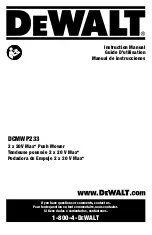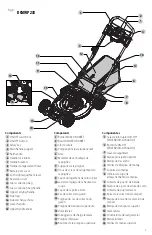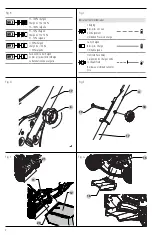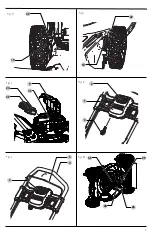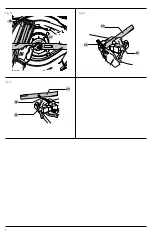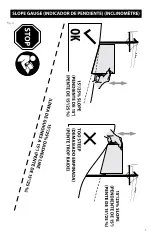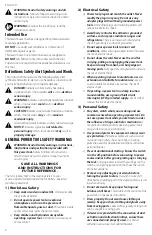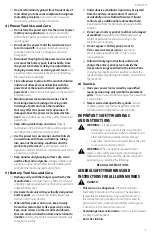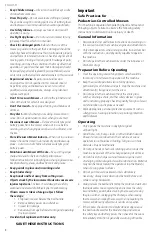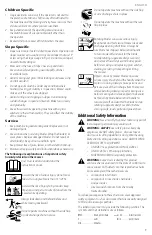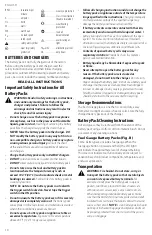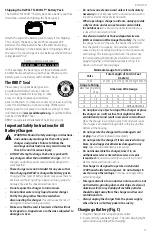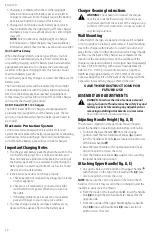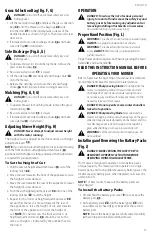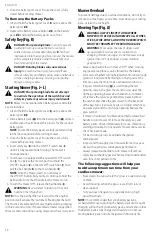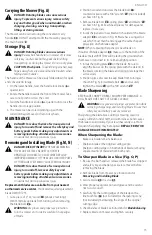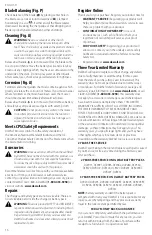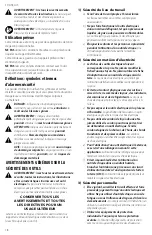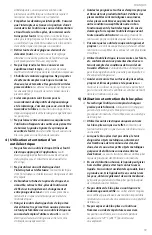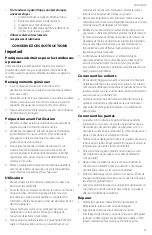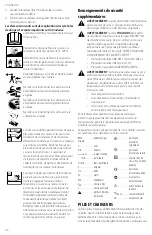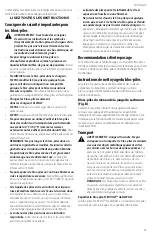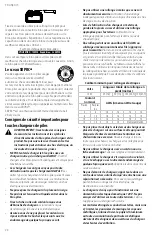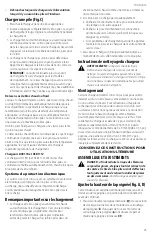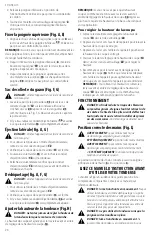
11
English
•
Do not use an extension cord unless it is absolutely
necessary.
Use of improper extension cord could result in
risk of fire, electric shock or electrocution.
•
When operating a charger outdoors, always provide
a dry location and use an extension cord suitable
for outdoor use.
Use of a cord suitable for outdoor use
reduces the risk of electric shock.
•
An extension cord must have adequate wire size
(AWG or American Wire Gauge) for safety.
The smaller
the gauge number of the wire, the heavier the cord and
thus the greater its capacity. An undersized cord will
cause a drop in line voltage resulting in loss of power and
overheating. The following table shows the correct size
to use depending on total length of all extension cords
plugged together, and nameplate ampere rating. If in
doubt, use the next heavier gauge.
Minimum gauge for Cord sets
Volts
Total length of Cord in Feet
(meters)
120V
25 (7.6)
50 (15.2) 100 (30.5) 150 (45.7)
Ampere Rating
American Wire gauge
More Than Not More
Than
0
6
18
16
16
14
6
10
18
16
14
12
10
12
16
16
14
12
12
16
14
12
Not Recommended
•
Do not place any object on top of the charger or place
the charger on a soft surface that might block the
ventilation slots and result in excessive internal heat.
Place the charger in a position away from any heat source.
The charger is ventilated through slots in the top and the
bottom of the housing.
•
Do not operate the charger with a damaged cord
or plug.
Have them replaced immediately.
•
Do not operate the charger if it has received a sharp
blow, been dropped or otherwise damaged in any
way.
Take it to an authorized service center.
•
Do not disassemble the charger; take it to an
authorized service center when service or repair
is required.
Incorrect reassembly may result in a risk of
electric shock, electrocution or fire.
•
The charger is designed to operate on standard
120V household electrical power. Do not attempt to
use it on any other voltage.
This does not apply to the
vehicular charger.
•
Foreign materials of a conductive nature, such as, but
not limited to, grinding dust, metal chips, steel wool,
aluminum foil or any buildup of metallic particles
should be kept away from the charger cavities and
ventilation slots.
•
Always unplug the charger from the power supply
when there is no battery pack in the cavity.
Charging a Battery (Fig. C)
1. Plug the charger into an appropriate outlet.
2. Insert and fully seat battery pack. The red charging light
will continuously blink while charging.
Important Safety Instructions for All
Battery Chargers
WARNING: Read all safety warnings, instructions,
and cautionary markings for the battery pack,
charger and product. Failure to follow the
warnings and instructions may result in electric
shock, fire and/or serious injury.
•
DO NOT attempt to charge the battery pack with
any chargers other than a
D
e
WALT
charger.
D
e
WALT
chargers and battery packs are specifically designed to
work together.
•
These chargers are not intended for any uses other
than charging
D
e
WALT
rechargeable battery packs.
Charging other types of battery packs may cause them to
overheat and burst, resulting in personal injury, property
damage, fire, electric shock or electrocution.
•
Do not expose the charger to rain or snow.
•
Do not allow water or any liquid to enter charger.
•
Pull by the plug rather than the cord when
disconnecting the charger.
This will reduce the risk of
damage to the electric plug and cord.
•
Make sure that the cord is located so that it will not
be stepped on, tripped over or otherwise subjected to
damage or stress.
The RBRC® Seal
Please take your spent battery packs to
an authorized
D
e
WALT
service center or
to your local retailer for recycling. In some
areas, it is illegal to place spent battery
packs in the trash. You may also contact your local recycling
center for information on where to drop off the spent
battery pack. Do not place in curbside recycling. For more
information visit
www.call2recycle.org
. or call the toll free
number in the RBRC® Seal.
RBRC® is a registered trademark of Call 2 Recycle, Inc
.
shipping the
D
e
WALT
FlEXVOlT™ Battery Pack
The
D
e
WALT
FLEXVOLT™ battery pack has a battery cap that
should be used when shipping the battery pack.
Attach the cap to the battery pack to ready it for shipping.
This converts the battery pack to three separate 20V
batteries. The three batteries have the Watt hour rating
labeled “Shipping” on the battery pack. If shipping without
the cap or in a tool, the pack is one battery at the Watt hour
rating labeled “Use”.
Example battery pack label:
USE: 120 Wh SHIPPING: 3 x 40 Wh
In this example, the battery pack is three batteries with
40 Watt hours each when using the cap. Otherwise, the
battery pack is one battery with 120 Watt hours.
Содержание DCMWP233
Страница 5: ...3 Fig J Fig K Fig M Fig L Fig H Fig I 22 10 22 25 24 23 9 3 1 2 4 5 26 29 28 10 2 33 ...
Страница 6: ...4 31 29 32 29 31 33 Fig O Fig N 30 27 Fig P ...
Страница 7: ...5 Fig Q ...
Страница 47: ......

